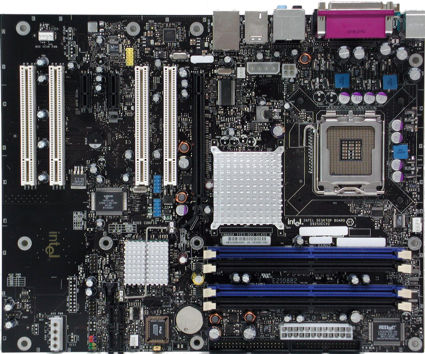Market Survey, Part 2: Six Premium Pentium 4 LGA775 Boards
Intel D925XECV2 (Intel 925XE)
Unmistakable: the huge, glued down, passive Northbridge cooler and the black color scheme are characteristic of Intel motherboards.
Board revision: 2.03
BIOS version: 0404
Intel wields a considerable amount of influence in the motherboard business. Over the course of the last few years, its product assortment has steadily grown, and Intel now offers 16 boards for the 900 series chipsets alone. For the coming 945/955 platform (Lakeport/Glenwood), another 13 boards are on the roadmap. In the future, Intel intends to use its five categories for better classification: the Extreme, Media, Executive, Classic, and Essential series. Some boards fall into more than one category.
The board on the test bed this time is called Culver City 2, and has ample features, though it doesn't quite live up to the bonanza offered by Asus and Gigabyte's boards. Three FireWire ports are available, along with four SATA connections and a floppy and UltraATA/100 connection for each of the chipsets. The sound system is HD Audio-compliant. Intel includes a small front module for installing in a 3.5" drive bay. A FireWire connection, two USB 2.0 ports and audio ports can be used here on the front of the computer. Both a white and a black panel are provided.
Intel only cools its chipset components passively. Two fan connections with four pins, and a connector with three pins, allow two case fans to be hooked up. If you are wondering about the slot arrangement, you should know that Intel uses the same layout as for a MicroATX motherboard, leaving out only the two left PCI slots. That is also why so much of the board's surface goes unused. With desktop motherboards, Intel still has not integrated a pair of Gigabit network ports, sticking with a Marvell chip connected via PCI Express.
To remain competitive, Intel can't help but include overclocking functions too. However, one particular feature they certainly don't offer is unlocking the x14 multiplier via the performance requirement bit. After all, it's better for them if customers invest more money for a faster processor!
Get Tom's Hardware's best news and in-depth reviews, straight to your inbox.
Under testing, the board occasionally got hung up on post code error 80. We got around the problem by turning the system off and then back on again. Using a replacement board didn't resolve the error either. We surmise that this could be caused by the current BIOS version with support for the Pentium 4 600 series .
| Intel D925XECV2 (Rev. 203) | |
|---|---|
| Platform | Sockel LGA775 |
| Northbridge | Intel 925XE |
| Southbridge | Intel ICH6R |
| BIOS | unknow |
| Memory | DDRII-333 to 533 |
| Interfaces | |
| Connectors | onboard/panel |
| USB 2.0 | 4 / 2 |
| IEEE1394/Firewire | 1 / 1 |
| Serial COM Port | 1 / none |
| Parallel LPT Port | 1 / none |
| Game | none / none |
| LAN | 1 / none |
| WLAN | none / none |
| SATA | 4 / none |
| Audio analog | 5 / 2 |
| Audio digital | 2 / none |
| Connectors | onboard only |
| PCIe 16x | 1 |
| PCIe 1x | 2 |
| PCI | 4 |
| IDE (PATA) | 1 (2 channels) |
| Fan 4 pins (CPU) | 1 |
| Fan 3 pins (System) | 3 |
| Mass Storage Controller | |
| ICH6R | 2x IDE (ATA100)4x SATA (RAID 0,1,0+1) |
| LAN | |
| Marvell 88E8053 PCIe | 1x 1 Gbit/s LAN |
| Audio | |
| Realtek ALC880 7.1 | AC97 (HD-Audio) |
| IEEE1394/Firewire | |
| agere FW323-06 | 2x 1394a (400 Mbit/s) |
| Clock Setting in BIOS | Measurement |
|---|---|
| 200.0 MHz (FSB800) | 200.0 MHz (+ 0.00 %) |
| 266.6 MHz (FSB1066) | n/a |
| SPD Memory Timing Recognition | Timing Result |
| FSB800 setting | CL 3.0-3-3-6 |
| FSB1066 setting | n/a |
Current page: Intel D925XECV2 (Intel 925XE)
Prev Page MSI 925X Neo Platinum, Continued Next Page Intel D925XECV2, Continued
Patrick Schmid was the editor-in-chief for Tom's Hardware from 2005 to 2006. He wrote numerous articles on a wide range of hardware topics, including storage, CPUs, and system builds.
